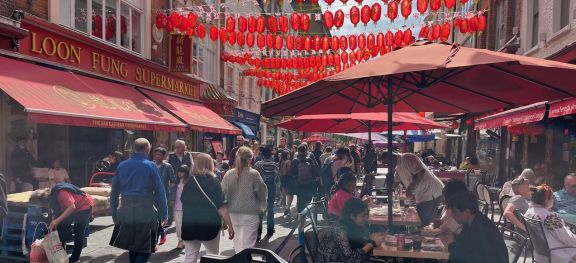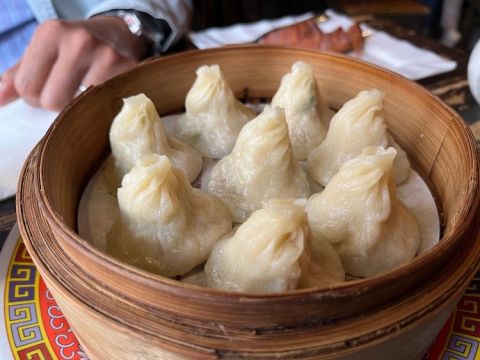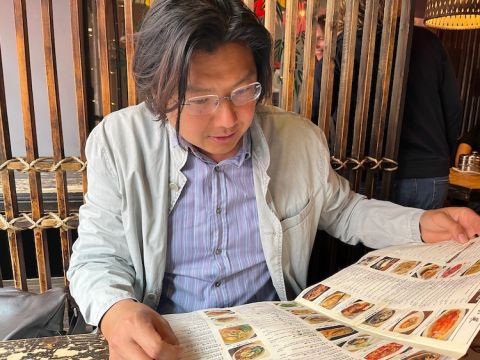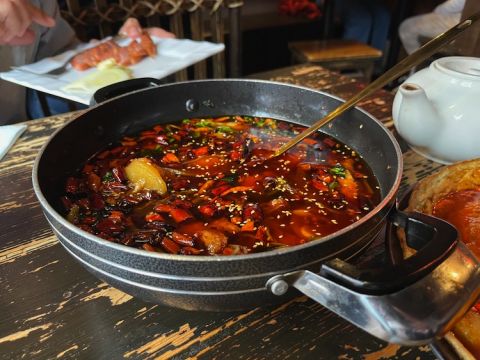The Leongs of Chinatown

The inside story of London's Chinatown. Its main thoroughfare Gerrard Street is seen above.
It was just before 1 pm and I was waiting at the round table that had been booked for 10, all of us colleagues during the late 1970s at a commodity trading company, when I was approached by a Chinese man with enviably long black hair. ‘Are you the host?’ he enquired. It was too inconvenient to explain that my only role was to order the food for the table so I assented. ‘Well’, came the response, ‘we’ve just had a message that a certain Jeremy Taylor is on his way but that he may be lost.’ He then suggested that we go out and look for him.
We waited at the entrance to Dumplings’ Legend restaurant and introduced ourselves to each other. He said that his name was Geoffrey Leong and that he was the owner of the restaurant. As we waited, watching the crowds swarming along Gerrard Street, the main street in London’s Chinatown, he explained that formerly the building had been Lee Ho Fook, the first Chinese restaurant in the UK to be awarded a Michelin star. Before then it was the Mont Blanc Club of which, according to him, Joseph Conrad, Hilaire Belloc, G K Chesterton and Galsworthy were members.
We enjoyed our lunch, particularly the prawn cheung fun, the turnip cakes, the glutinous rice and their speciality, the xiao long bao dumplings shown above, all washed down with beer. As our plates were being cleared away, back came Leong. ‘I trust you enjoyed your meal but I see you haven’t tried our mango dessert. Would you mind if I sent some over?’ he enquired, obviously expecting us to agree. He promptly swamped us with kindness, sending several plates of several desserts: not just mango pudding but a coconut pudding and a plate of egg tarts. Intrigued to encounter anyone in a Chinatown restaurant as generous as this, I suggested we meet for lunch.
We arranged to meet on a day when, due to one of London’s too-frequent train strikes, most city streets were quiet. But as usual Gerrard Street was packed, with a queue beginning to form outside the Four Seasons restaurant, still justifiably renowned for its roast duck.
We were to meet at Leong’s Legend, a restaurant directly opposite the Four Seasons that members of his family had first opened on 2 June 2008 to serve the traditional but less well known dishes of Taiwan in a building that boasts two plaques: one a green Westminster plaque that boasts that here was the home of the Penny Post from 1794 to 1804, and a blue plaque pointing out that this was the site of the famous Ronnie Scott’s Jazz Club from 1959 to 1965. How had the Leongs managed to occupy two such eminent sites on either side of what must be the busiest pedestrianised street in London (but most of whose restaurants really could do with a deep clean and a lick of paint)?
I found Leong at a table by the window carefully studying the menu, a four-page colour affair with the strapline, ‘The Leong’s Legend Times’ and a red company chop in the top right-hand corner.
The menu is vast, as is that at Dumplings’ Legend which lists over 200 items, but that at Leong’s Legend is far more colourful, with lots of photos to encourage the uninitiated. He offered to order and went on to choose several of his favourite Taiwanese dishes: a large Taiwanese oyster omelette (above), a dish of eight xiao long bao, a plate of Taiwanese sausage, a spring-onion pancake and, most potently, the dish shown below that was described simply as ‘chicken cooked with beer’. It is given a single-chilli rating on the menu but deserves more in my opinion.
I then settled back and listened.
‘My family are from Hong Kong where my grandparents were very successful in business’, began Leong. ‘They had a house on Repulse Bay where Stanley Ho [the mogul who made Macau into a gaming hub] was a tenant once. My grandmother had a funeral business that she claimed was a reason the Triad gangs left us alone when we opened in London. I was born in 1976 and, in 1986, anticipating the Chinese takeover of Hong Kong, we moved to London where I went to public school, Rugby, and to UCL where I was to meet my future wife.
‘Underlying it all was the Chinese love of food and feasting which seems to run through my family. I don’t know whether you remember’, and here he stopped briefly to catch my eye, ‘but there was a group of Chinese restaurants called Zen in London?’ I nodded in agreement, recalling the strikingly modern architecture of ZeNW3 in Hampstead which had delighted many during the 1980s. ‘That was the work of the architect Rick Mather but the inspiration for the whole group, an exciting take on Cantonese cooking, was my uncle Lawrence Leong.
‘It was my father and his brother who first established themselves in the restaurant business in London through a collective love of food. We took over the building at 15/16 Gerrard Street and then developed the company.
‘My student years coincided with the Café de Paris [a nightclub] and then later I was involved with the Old Vic Tunnels [an art and performance space] under Waterloo. I’m good friends with some of the members of the Young British Artists movement and I’ve raised money for the Barbican. All of which reinforces my love of food and of making people happy. It seems to have worked out’, he said with a smile.
And what observations does he have on Gerrard Street, I wondered. ‘It is unquestionably one of the city’s busiest streets’, he observed, ‘but that means that the restaurants have to be busy. How much do you think the rents are here?’
‘Perhaps £100 per square foot?’ I ventured. Leong laughed. ‘The buildings on this street are divided into units and are measured in units of six metres back from the street. If you have a property facing the street you will have to pay about £400 per square foot, a bit less for anything deeper. The Chinese restaurateurs joke that we are paying the pensions of all those who own the freeholds that are now controlled by the Shaftesbury Capital group.’ (Asking around, I have been told that restaurant rents per square foot are around £60 south of the river in Battersea, Marylebone is approaching £100, Soho has crept back up to £100 with Covent Garden slightly more – but nothing like £400.)
This helps to explain, to some extent, the swift service, the rapid turning of tables, and the not infrequent brusqueness of the welcome and the service in Chinatown. I asked Leong how many customers Dumplings’ Legends can seat over its three floors. He stopped to calculate, finally plumping for about 200. I then asked him how many times each table was turned, occupied by a new set of diners. He would not be drawn on this but seemed to nod in agreement when I suggested four to five, accommodating up to a thousand customers on a busy Saturday or Sunday. More, he agreed, around Chinese New Year when the crowds swarm into Gerrard Street day and night.
I do enjoy Gerrard Street and all that London’s Chinatown has to offer. It is the closest Londoners can easily get to the Central District of Hong Kong. But I can also fully understand why others such as restaurateur Alan Yau and chef Andrew Wong have chosen to open anywhere but Gerrard Street. The whole street continues to suffer from a lack of investment and of tender, loving care from its restaurateurs. Perhaps during its quietest fortnight of the year, one side could close for one week, the other for the next week, so that it could all be brought into the 21st century.
Dumplings’ Legend 15/16 Gerrard Street, London W1D 6JE; tel: +44 (0)20 7494 1200
Four Seasons 12 Gerrard Street, London W1D 5PR; tel: +44 (0)20 7494 0870
Leong’s Legend 39 Gerrard Street, London W1D 5QD; tel: +44 (0)20 7434 0899
Become a member to view this article and thousands more!
- 15,408 featured articles
- 275,024 wine reviews
- Maps from The World Atlas of Wine, 8th edition (RRP £50)
- The Oxford Companion to Wine, 5th edition (RRP £50)
- Members’ forum
- 15,408 featured articles
- 275,024 wine reviews
- Maps from The World Atlas of Wine, 8th edition (RRP £50)
- The Oxford Companion to Wine, 5th edition (RRP £50)
- Members’ forum
- 48-hour preview of all scheduled articles
- Commercial use of our wine reviews





